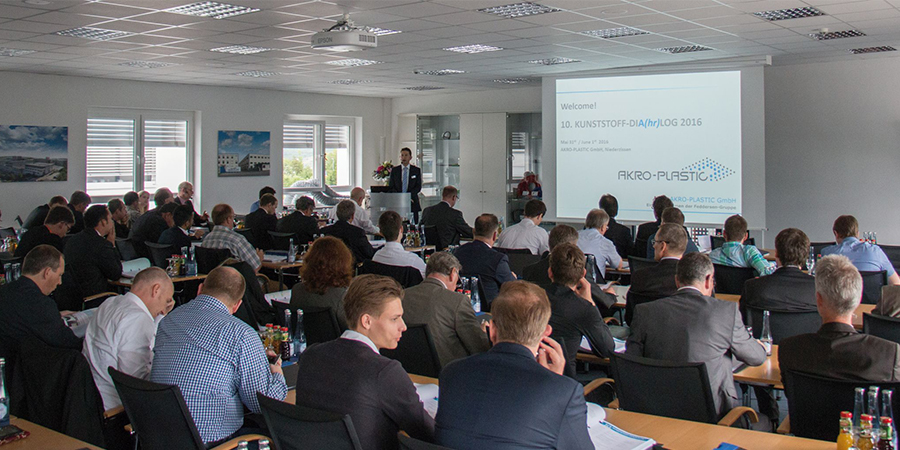On 31 May and 1 June 2016, AKRO-PLASTIC GmbH, the specialist for innovative and application-oriented plastics compounds, invited guests to participate in the tenth KUNSTSTOFF-DIA(hr)LOG® conference in Niederzissen, Germany. The anniversary event, headlined "Creating Value", took place in front of a "sold-out" crowd. Simultaneous interpreting services made the event worthwhile for international guests as well.
"What's behind our 'Creating Value' theme", asked Leander Bergmann, Head of Marketing at AKRO-PLASTIC and event host. "We want to work with you to generate added value, providing you with a competitive edge that will secure your business over the long term and allow it to grow".
Prof. Dr. Walter Wincheringer from Koblenz University of Applied Sciences kicked off the two-day event with his presentation on Industry 4.0. In a vivid demonstration, he revealed how Industry 4.0 does indeed make a useful contribution to value creation in the case of extensively networked processes, even if to some it still appears to be quite an elusive concept. "The purpose of Industry 4.0 is to 'relieve' staff members, not to 'release' them", Prof. Dr Wincheringer quipped. "Systems designed to replace staff are not constructive. Instead the focus should be on implementing production processes that preserve resources and enhance efficiency. Software and information technology will play a key role here", he added.
Resource efficiency truly is the challenge of the century, as elucidated by Prof. Dr Christian Bonten from the Institut für Kunststofftechnik (IKT) in Stuttgart. Using a number of examples, he showed the contribution that plastics can make to boost productivity, increase material efficiency, and improve energy efficiency. "The free market fails when it comes to long-term issues such as resource politics", Prof. Bonten stated. "Resource prices inflated by taxes do not entirely offset efficiency gains, thereby promoting further investment in efficiency".
Justin Jin, CEO of Korea-based Axia Materials Co. Ltd., gave a focus presentation on the opportunities afforded by organo sheets for creating added value. He showed an impressive array of development projects that can be realised with organo sheets in his various market‑capable process stages. The success already achieved with the concept of producing entire houses using this material was impressive indeed.
Dr Frieder Lörcher and AnDreas Gross from Ziehl-Abegg SE also presented a success concept. In great depth they explained how, through multidisciplinary partnerships, ideas could be implemented and genuine added value created in a very short time. The audience was extremely impressed by the high-efficiency diagonal fans and tool technology developed for production they presented. "Through productive interdisciplinary partnerships, we were able to achieve improved efficiency and acoustic values resulting from more degrees of freedom in the shaping process and the conversion to plastic", Dr Lörcher reported.
The second day of the event began with a talk by AKRO-PLASTIC GmbH. Thilo Stier, Head of Sales & Innovation, presented trends in highly reinforced plastics. Mr Stier made it clear that to increase efficiency, a favourable material price is not the only important factor. Improved mechanical properties, the use of partially aromatic polyamide or high-fill polyamides with up to 60% glass-fibre content, and specifically reduced-density materials, for instance, can all make a significant contribution. "Particularly in the automotive industry and taking into account the CO2 upper limit of 95 g/km set to take effect in 2020, these measures deliver significant potential for savings", Stier explained.
Dr Volker Gorzelitz, Managing Director of M.TEC, engineering company for plastic product development Ltd, then showed how, through topology optimisation, we are now able to calculate components for lightweight designs modelled on nature. The example he presented confirmed that by performing structural optimisation simulations early in the development process, it is possible to determine the optimal structure of components whilst taking the anisotropies into account, thereby utilising the full potential of the lightweight construction.
Gerhard Niederlechner from Hotec explained how to repair everyday injection mould damage and how to prevent it altogether with optimal pre-treatment and coating, providing a detailed description of the various methods for successive surface optimisation. This made it clear that materials and processes are not the only contributing factors when it comes to the value chain. To a very significant degree, the quality and condition of the mould are also of key importance.
In conclusion, Dr Rene Fuhrich from Robert Bosch GmbH addressed the topic of optimised infra-red welding technology for highly reinforced plastics. He noted that the use of IR welding for filled plastics makes it even more important to select optimal process parameters. "The temperature should not normally exceed the critical mass. The correct distance must be maintained", explained Dr Fuhrich.
Leander Bergmann wrapped up the two-day event with the following summary: "In the two days of this event, we have examined a number of processes occurring in your operations and ours and have more or less come full circle. An intelligent linking of processes, self‑controlling and auto-adapting through Industry 4.0, create added value in our daily work". Bergmann is looking forward to another good turnout at next year's event.
The 11th KUNSTSTOFF-DIA(hr)LOG® will take place in Niederzissen on 9 and 10 May 2017.

 English
English Chinese
Chinese